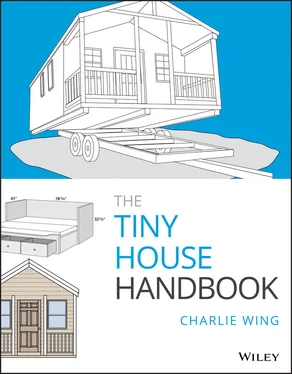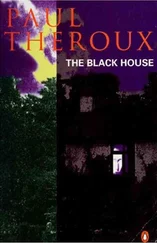Charlie Wing
The Tiny House Handbook
For the next generation… in hopes they restore us to sanity
The idea of living in a tiny house is not new. Outside of the developed world, most of the world’s people live in shelters no larger than those now defined in the US as “tiny” (less than 400 square feet). We have all read of and seen photographs of the Eskimo igloo, Native American teepee, Bedouin Arab tent, Gypsy vardo, Mongolian yurt, and Aboriginal dome. These are not temporary shelters, nor are they what Americans call “starter homes.” Rather, they are, and have been for millennia, the standard homes for their cultures.
For reasons this book does not address, the average new home in the US has grown to 2,400 square feet of living space, four bedrooms, three bathrooms, and a two-car garage. While many, and probably most, Americans aspire to ownership of these McMansions, an increasing number are questioning, “What if a person gets everything and it’s not enough?”
The tiny house movement is not just about tiny houses. It’s about lifestyle; it’s about less is more; it’s about a smaller footprint but a larger life.
There are already many books on the tiny house philosophy and lifestyle. Most contain photos of tiny homes on wheels parked in dramatic settings and a myriad of clever ideas for the utilization of small spaces. Few, however, offer much guidance on how to proceed from present situation (usually a house that no longer fits or no home at all) to a tiny home fulfilling one’s dream.
The Tiny House Handbook leads you through the full process from discovery (just what is a tiny home?) to the regulatory minefield of codes and zoning, to cost estimates, to design, to the actual construction (yes, you can build it yourself).
Thirty years ago I had the idea of compiling a massive amount of information on residential construction into a Visual Handbook of Building and Remodeling. Two things the project required were: 1) my residence for a month in the Washington DC libraries of virtually every building trade association in the nation, and 2) someone to convince a publisher that such a project could be profitable.
This project, The Tiny House Handbook , was researched without my ever having to leave home. Thanks to the internet I was able to “pick the brains” of dozens of tiny home pioneers through their books, blogs, and articles. So, although too many to enumerate, let me acknowledge their unknowing contributions.
The second requirement, a person to sell the idea to a publisher, was fulfilled by Ray Wolf, my agent both then and now. I think it fair to say at least a dozen of my subsequent books, including The Tiny House Handbook , would have never seen the light of day without his powers of persuasion.
This project required a third element. Because tiny homes are an evolving phenomenon, I needed a insider, an observer, and a player in the trenches. That person has, and continues to be, Corinne Watson, founder and president of Tiny Homes of Maine. Thank you, Corinne.
Finally, and perhaps mostly, I have to thank the one who makes me glad to wake every morning, my soulmate, Barbara Rogerson.
Charlie Wing is a nationally recognized home building/improvement/repair expert. He has written or co-written more than 20 books on these topics, including Home Depot’s Decorative Painting, Tiling, and Plumbing 1-2-3 books, Better Homes & Gardens’ Complete Guide to Home Repair , Taunton Press’s The Visual Handbook of Building and Remodeling and The Visual Handbook of Energy Conservation , Reader’s Digest’s The Big Book of Small Household Repairs , and many others, including Ortho’s Home Improvement Encyclopedia and How to Build Additions.
An MIT PhD, Charlie has been a guest more than 400 times on home improvement radio and television shows, including on the Discovery Channel, PBS, and NBC’s Today Show. He developed and hosted a national PBS series on home remodeling for energy efficiency. He was founding and technical editor for Smart Homeowner magazine from 2001 to 2004.
My love affair with tiny houses began in 1972. I was teaching physics at Bowdoin College and was asked to lead a senior seminar on any subject I knew nothing about. Bowdoin was experimenting with the notion of students learning to learn through emulation of the teacher in exploring a new subject.
One subject I knew nothing about was how buildings, in particular houses, worked or didn’t work from the viewpoint of physics. I admit to having chosen the subject selfishly. The 1794 Maine farmhouse I had recently purchased was a preservationist’s dream—as free of insulation, weatherstripping, and mechanical systems as the day it was born. Situated at the very top of a bare hill, on a windy night the best it could do was lower the speed of the infiltrating wind.
The seminar proved popular, not only among the Bowdoin students (they called the course “Hammer and Nails”), but also among a growing number of auditing back-to-the-land hippies wanting to construct their own shelters.
From a personal standpoint the course was a great success, for it resulted in an overwhelming urge to build my own energy-efficient passive solar house. Hearing of my desire, two of the graduating seniors asked if they could help. Both Jan Pierson and Steve Alcaide had scored an A on the final exam, and both were strong as bulls. How could I refuse?
The employment agreement was, for the summer: a room in the farmhouse, board, and the minimum wage at the time of $2.75/hour.
On the agreed starting date the two young men arrived on motorcycles. Behind each was a large duffel bag—and an enthusiastic young lady. I was, they informed me, getting four workers for the price of two. How could I refuse?
But, as so often happens, reality soon raised its head. That evening I held a crew meeting and presented several issues. First, my family of four plus the crew of four made eight people in just three bedrooms. Second, a rainy May had extended Maine’s mud season, keeping the mile-long cowpath to the building site impassable. Third, not unexpected, and yet not insignificant, none of the crew had any prior carpentry experience.
The following morning the crew proposed a solution. If I supplied the materials, they would learn carpentry by building without pay a small cabin on site. There they would sleep and cook their own meals. At the end of summer I would have a guest house or writing shack for the cost of materials alone. The looks on their young faces reminded me of my dog’s upon presentation of the retrieved ball. The energy generated among the four could have powered a small town. How could I refuse? Off they went on the motorcycles. Over his shoulder one yelled, “We’re gonna do a charette!” (Look it up.)
In late afternoon they returned with a rough sketch for a 12’ by 20’ solar shed with two sleeping lofts. Over the next four days I produced foundation, framing, and sheathing drawings accurate to 1/8” inch while they measured, cut, and numbered every piece in my workshop. The following Monday they loaded all onto my farm tractor and trailer and plowed their way through the mud to the building site. One week later they moved into the shell of their tiny home.
The little house on its foundation of telephone poles and containing a compressed but complete kitchen, tiny wood stove, and two sleeping lofts, has now been continually occupied by single and couple tenants for forty-eight years.
Читать дальше












